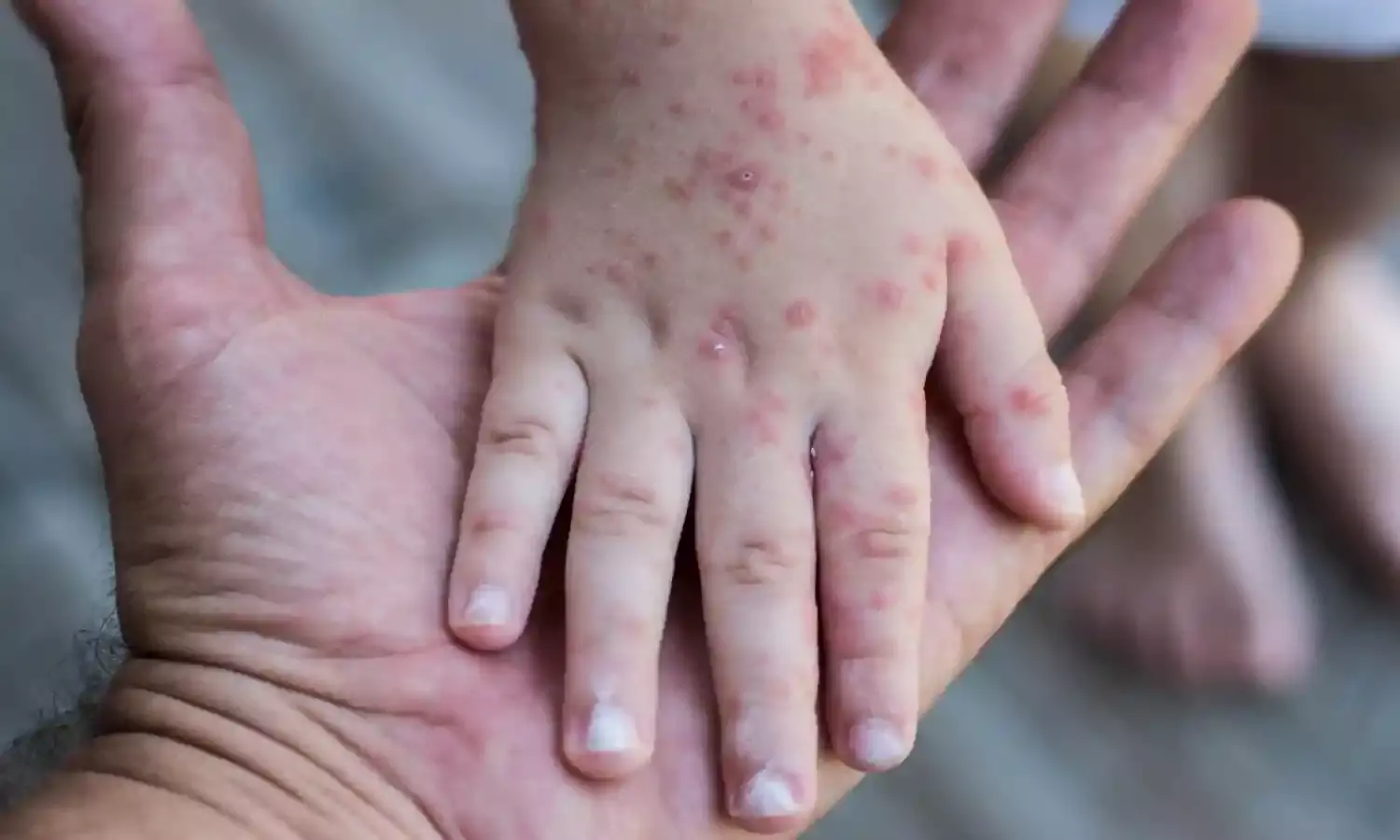Tomato Fever: All You Need to Know About the New Viral Illness in India
'Tomato fever' or Hand, Foot and Mouth Disease which is mostly found in children is NOT a serious illness as claimed by the media, say experts.

Image Credit: Coxsackie virus. Symptom of hand, ears, foot and mouth disease. Painful rash red spots blisters on the hand / Shutterstock.com
More than 82 cases of a new illness called 'tomato fever' have been recorded in children below five years in Kerala and Odisha. On August 17, 2022, The Lancet, a medical journal, in its report, highlighted that the rare viral infection is in an endemic state in the country and is considered non-life-threatening.
According to the Respiratory Journal, the flu was first identified in the Kollam district of Kerala on May 6, 2022. Additionally, 26 children between ages 1 and 9 , have been reported as having the disease in Odisha by the Regional Medical Research Centre in Bhubaneswar. As of August 24, 2022 only Kerala, Tamilnadu, and Odisha have been affected by the virus.
The spread of this virus has also been accompanied by misinformation on social media and unnecessary panic among the public. To understand the facts around the flu, FactChecker spoke to Dr Rajeev Jayadevan, Senior Consultant Gastroenterologist and Co-Chairman of Indian Medical Association's National COVID-19 Task Force.
According to Dr Jayadevan, the current flu is the variant of the hand, foot, and mouth disease (HFMD), a common infectious disease affecting mostly children between one and five years and immunocompromised adults.
Cause and Symptoms
HFMD is a viral infection caused by a strain of Coxsackievirus. Like the common cold or fever, the HFMD infection is contagious and may spread by direct contact with nose and throat discharges, blisters and faeces (stools) of infected people, according Dr Jayadevan.
The primary symptoms of this virus are high fever, blister-like red rash, joint pain, fatigue, nausea, vomiting, diarrhoea, fever, dehydration, swelling of joints, body aches, and common influenza-like symptoms.
"They typically appear on the palms of the hand and soles of the feet," said Dr Jayadevan. The blister-like red rashes can further appear on other parts of the body of the child. In terms of size, the blisters could resemble a peppercorn or a piece or black pepper. "It's not an illness that a parent can ignore but it's not any more serious than the usual viral cold that a child can get," he added.
Further, a person is contagious when the first symptoms appear and may continue until the blister-like skin rashes disappear.
HFMD or 'tomato fever' is non-life-threatening
According to Dr Jayadevan, the public need not be alarmed by HFMD. However, they need to keep four things in mind:
First, this is a self-limiting disease, it goes away on its own. "You can treat this disease just as you treat a common cold or fever, make sure the child is hydrated and basic hygiene is maintained such as regular handwashing. Complications are extremely rare," the gastroenterologist said.
Second, it is not caused by tomatoes. "Tomato-fever has nothing to do with tomatoes or any other fruit or vegetables. So please do not hesitate to buy tomatoes or eat them," he said.
Third, the blisters do not grow to the size of tomatoes. While The Lancet has mentioned that the blisters gradually enlarge to the size of tomatoes, it is not the case, according to Dr Jayadevan.
Fourth, although the symptoms for HFMD are similar to other viral infections such as SARS-CoV-2, Monkeypox, Dengue and/or Chikungunya, they are not related.
"It was incorrectly claimed by someone, who, perhaps, had no medical training. When such a statement is made, it unnecessarily worries the layperson. The term 'tomato fever' has stirred up a lot of controversy. When we try to explain a disease, it is important to consider the far reaching consequences of misinforming the public," Dr Jayadevan said.
Treatment
HFMD has no specific treatment. "The best solution for prevention is the maintenance of proper hygiene and sanitisation of the surrounding necessities and environment as well as preventing the infected child from sharing toys, clothes, food, or other items with other non-infected children," The Lancet recommends.
Dr Jayadevan too suggested similar precautionary measures. "Encouraging children to perform good hygiene, keeping the child at home for a few days till they recover, and disinfecting surface areas are some of the ways in which the illness can be prevented," he concluded.


